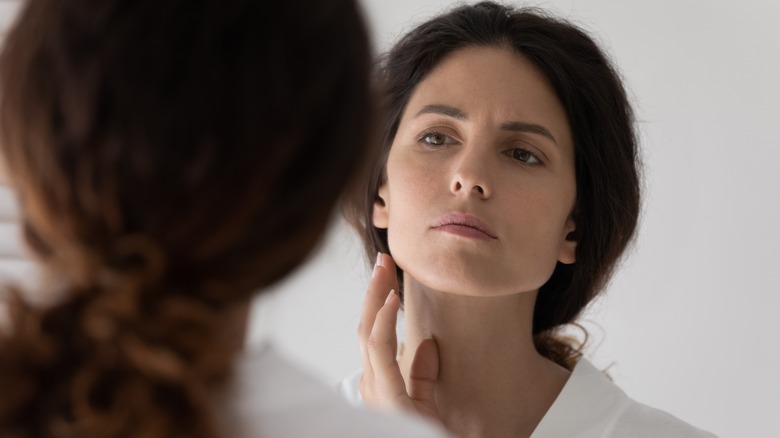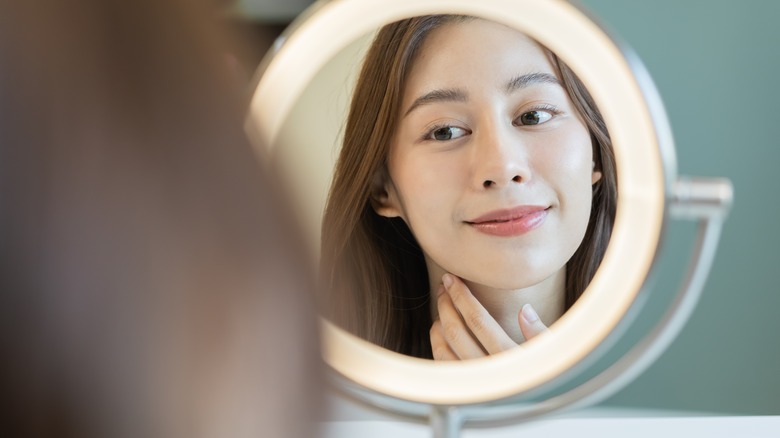How To Identify And Treat Sallow Skin
Skin is the body's largest organ, and besides that making for a fun fact in biology class, this tidbit of information is super relevant to our lives outside the classroom. Sometimes, ailments and conditions that occur deeper in the body are only detected through the skin. This is often the case with skin issues like adult acne, for instance, which may point to hormonal imbalances or stress, or rashes, which can be a sign of diseases such as lupus.
Another skin issue to watch out for: sallowness. Sallow skin may not be as obvious as acne blemishes or inflamed patches, but it's still just as important to take note of. So what is it exactly? "Sallow skin is a condition where the skin yellows or browns," board-certified dermatologist Dr. Dendy Engleman told Women's Health. "As we age, chains of sugar molecules attach to skin proteins and over time cause a yellowish hue."
However, sallow skin isn't just a product of getting older. It can actually reveal underlying health issues and damage caused by certain lifestyle habits. Here's how to identify a sallow complexion and what to do to repair your skin.
How to know if you have sallow skin
If you're not sure whether you have sallow skin or not, the easiest way to identify it is to compare your current complexion to its usual state. "Everyone is born with [a] certain skin colour, but when your skin loses its natural colour and lustre due to certain unhealthy external and lifestyle factors, you are known to have sallow skin," Dr. Mrunal Shah Modi, a dermatologist and trichologist, explained to BeBeautiful. "This generally leads to the person's skin looking paler, yellower or darker than usual."
However, sallowness can look different depending on your skin tone. As board-certified dermatologist Dr. Hadley King shared with Women's Health, sallow skin appears yellow in people with pale or pink-toned skin, while those with warm olive tones may notice their skin turning brown. Those with naturally dark skin likely won't notice signs of sallowness. Generally, discoloration is easiest to spot on the face, so remove your makeup and any tinted skincare products and step in front of the mirror in a well-lit room to survey your complexion.
For a healthy complexion, stick to healthy habits
You've noticed your skin has turned sallow. Now what? To restore your glow, it helps to understand the true causes of sallow skin. According to Healthline, you may suffer from sallowness if you're anemic or your diet is lacking in vital nutrients. Specifically, your skin needs sufficient iron and vitamins including B12, C, A, E, and K to maintain a naturally bright, radiant tone. If you've recently adopted a restrictive diet or can't remember the last time you consumed a full serving of veggies, consider varying your meals to include more nutrient-dense foods.
Sallowness can also be caused by unhealthy habits like smoking and losing sleep. The former speeds up the aging process and deprives your skin of oxygen, while the latter keeps your body from sending key nutrients to the skin. Though it may be easier said than done, ditching tobacco products and clocking a full seven to eight hours of sleep might help keep sallowness at bay.
Finally, don't overlook your skincare regimen when treating discoloration. Always slather on SPF, as sun damage can also be a culprit of sallow skin, and look for chemical exfoliants — including AHAs, BHAs, and PHAs — to slough away dull skin cells. For a brightening effect, turn to skincare ingredients such as vitamin C and niacinamide, which are known to reverse hyperpigmentation.


